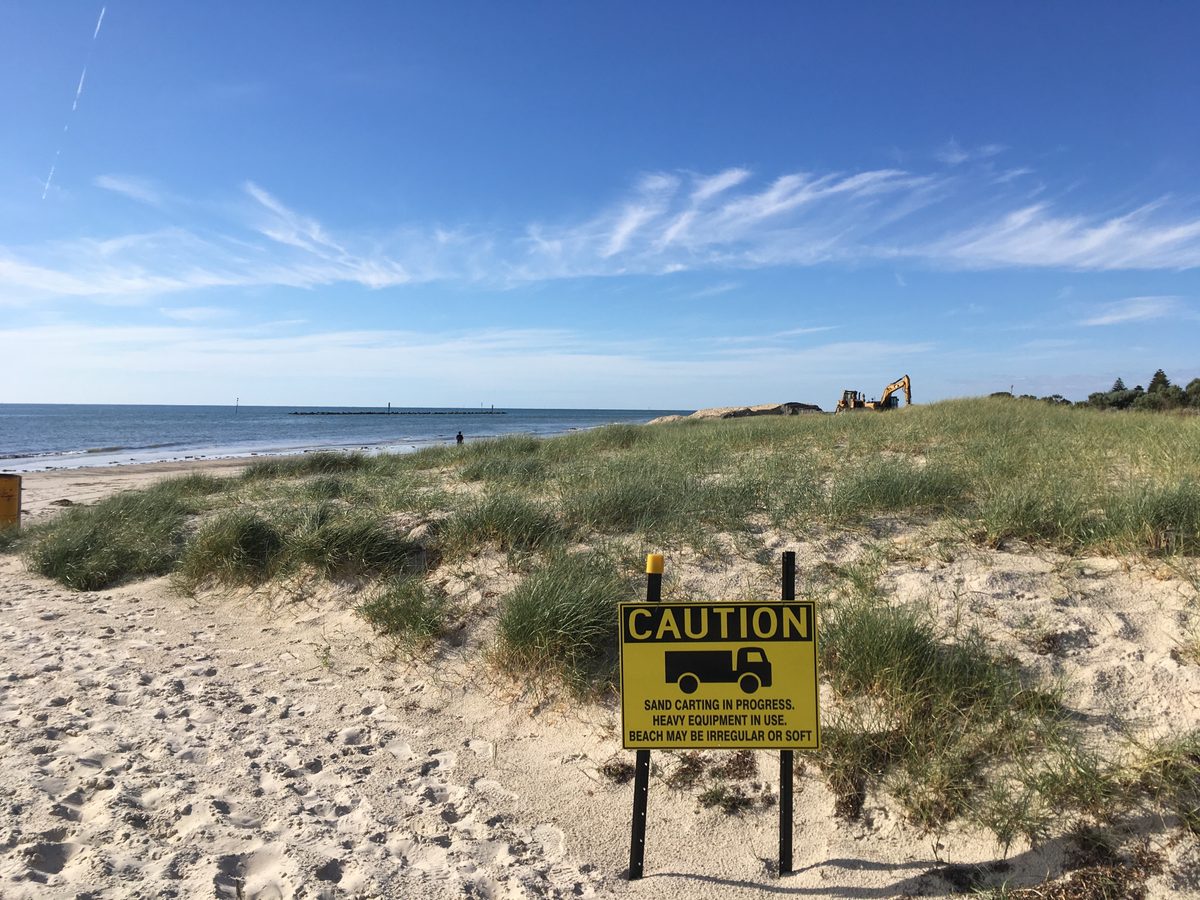Adelaide beach works
The Adelaide coastline is a highly modified environment as a result of urban development covering much of the original coastal dune system, impacting the natural coastal ecosystem. The state government has been actively managing Adelaide’s coastline for the last 50 years to protect property, the foreshore and infrastructure from storms while also providing sandy beaches for community enjoyment. Active management results in a beach system that is more resilient to storm damage.
The sand on Adelaide’s beaches naturally moves from south to north, driven by wind and waves. This causes erosion at the southern and central sections of the coastline, such as at Seacliff, West Beach and Henley Beach South, and a build-up of sand on other parts of the coastline, such as Glenelg, Semaphore and Largs Bay.
For half a century sand along the coastline has been moved from where it builds up to where it is needed. As necessary additional sand has also been brought into the system from external sources such as quarries and off-shore deposits.
In the southern section of the coastline sand is moved using an underground sand recycling pipeline from Glenelg to southern beaches to maintain dunes and keep those beaches sandy. Trucks are used elsewhere to replenish beaches.
Strong winds, large waves and storm surges, especially in the winter months, causes erosion of Adelaide’s beaches. The Department for Environment and Water monitors closely the entire coastline to determine where sand is needed. Sand movement works are generally undertaken during cooler months when there are fewer people on the beaches.
Read and watch videos about Adelaide Beach Management.
To stay informed about the latest news and updates, please subscribe to the Our coasts e-news.
Information on the Adelaide Beach Management review and dredging trial can be found here.

Latest updates
Other works
Beach and dune replenishment at the following locations is undertaken periodically
- Glenelg to Kingston Park sand recycling
- West Beach replenishment
- Henley Beach South replenishment
- Routine excavation of Torrens Outlet
- Semaphore Park dunes (between Third Ave and Mirani Court).
Community Safety
Community safety is a priority. Safety signage is in place on the beaches during works.
The community are asked to please take extra care on the beaches while the works are underway and adhere to all safety signage and flagging in place during operations.
- Qualified contractors are employed for the works. The successful contractor is required to develop a job safety plan and a thorough risk management plan. This includes safe management between the work and members of the public.
- Traffic control complies with relevant Australian Standards and Code of Practice. Traffic controllers and/or signage is provided where necessary.
- We liaise with local surf lifesaving and sailing clubs regarding beach safety.
- Temporary foreshore signage is installed prior to works commencing.
If you are concerned about community safety during beach replenishment works please contact our team at DEWCoasts@sa.gov.au or phone 8124 4928.
Truck speed limits on beaches
Sand movement works on Adelaide’s beaches are undertaken by a contractor on behalf of the department.
Safety is of paramount importance when undertaking works along our beaches. As such, the contract includes stringent conditions regarding the speeds that the equipment (trucks and other machinery) can operate at when moving along the beach.
Speed of vehicles on the beach shall not be greater than:
- 40 km/h unless within 50 metres of any person or animals
- 25 km/h between 10 metres and 50 metres of any person or animals
- Must stop within 10 metres of any person or animal.
All vehicles must give way to all other traffic on the beach including pedestrians and animals. They must stop when pedestrians or animals wish to cross the line of movement of the trucks along the beach.
DEW contractor truck speed limits are compliant with the recent changes to the Road Traffic Act 1961. The department also has a supervisor monitoring compliance with these conditions.
Like cars and other vehicles trucks may also be equipped with Dash Cams.

Shorebirds

DEW works closely with Birdlife Australia prior to and during beach replenishment operations to minimise any potential impacts on Red-capped and Hooded plovers during breeding season. DEW is updated regularly by Birdlife Australia with regards to shorebird activity along the metropolitan coastline.
If required DEW contracts the services of a trained Birdlife spotter who remains present on the beach during operations.
DEW coast’s team, supervisors and contractors are committed to on-going training with Birdlife Australia staff.


